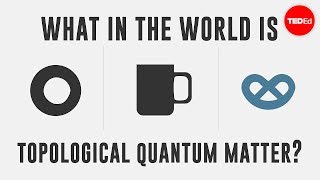(单词翻译:单击)
What if electricity could travel forever without being diminished?
如果电流可以一直毫无损耗地流动会怎么样呢?
What if a computer could run exponentially faster with perfect accuracy?
如果电脑的运行速度可以指数增长并保持准确无误会怎么样呢?
What technology could those abilities build?
什么样的科技才能使上述想象成真呢?
We may be able to find out thanks to the work of the three scientists who won the Nobel Prize in Physics in 2016.
也许我们可以找出一个方法,为此我们要感谢获得2016年诺贝尔奖的三位科学家。
David Thouless, Duncan Haldane, and Michael Kosterlitz won the award for discovering that
戴维·索利斯、邓肯·霍尔丹和迈克尔·科斯特利茨,他们三位因发现
even microscopic matter at the smallest scale can exhibit macroscopic properties and phases that are topological.
即使是最小尺度的微观物质也可以展现拓扑的宏观性质和各种相态而获奖。
But what does that mean? First of all, topology is a branch of mathematics that focuses on fundamental properties of objects.
但这是什么意思呢?首先,拓扑学是数学的一个分支,它关注物体的基本属性。
Topological properties don't change when an object is gradually stretched or bent.
当物体逐渐伸展或弯曲时,它的拓扑性质不会改变。
The object has to be torn or attached in new places.
物体必须被撕裂或附着在新的地方。
A donut and a coffee cup look the same to a topologist because they both have one hole.
在拓扑学家看来,一个甜甜圈和一只咖啡杯是毫无差别的,因为它们都有一个洞。
You could reshape a donut into a coffee cup and it would still have just one. That topological property is stable.
你可以把一个甜甜圈重塑为一只咖啡杯,它仍旧只会有一个洞。这种拓扑学属性是稳定的。
On the other hand, a pretzel has three holes.
从另一个方面讲,一个蝴蝶脆饼有三个洞。
There are no smooth incremental changes that will turn a donut into a pretzel. You'd have to tear two new holes.
没有平稳的、不断增加的改变可以使一个甜甜圈变成一个蝴蝶脆饼。你必须撕出两个新口子才行。
For a long time, it wasn't clear whether topology was useful for describing the behaviors of subatomic particles.
在很长一段时间里,人们并不清楚拓扑学能否用于描述亚原子粒子的行为。
That's because particles, like electrons and photons, are subject to the strange laws of quantum physics,
这是因为粒子,比如电子和光子,遵循奇怪的量子物理法则,
which involve a great deal of uncertainty that we don't see at the scale of coffee cups.
其中包含了很多不确定的因素,在咖啡杯的层面我们根本观察不到。
But the Nobel Laureates discovered that topological properties do exist at the quantum level.
但这三位诺贝尔奖得主发现,拓扑学的属性是存在于量子水平上的。
And that discovery may revolutionize materials science, electronic engineering, and computer science.
这个发现也许可以在材料科学、电子工程学还有计算机科学中引发革命。
That's because these properties lend surprising stability and remarkable characteristics to some exotic phases of matter in the delicate quantum world.
这是因为这些属性在微妙的量子世界里为物质的一些奇异相态提供了惊人的稳定性和显著的特征。
One example is called a topological insulator. Imagine a film of electrons.
举一个“拓扑绝缘体”的例子。想像一个电子薄膜。

If a strong enough magnetic field passes through them, each electron will start traveling in a circle, which is called a closed orbit.
如果有一个足够强的电磁场从中穿过,每一个电子就会开始进行圆周性的运动,这一轨迹叫做近轨。
Because the electrons are stuck in these loops, they're not conducting electricity.
因为这些电子都被困在这些环里,它们没有办法产生电。
But at the edge of the material, the orbits become open, connected, and they all point in the same direction.
但在材料的边缘,这些轨道变得开放、互联,并且有着相同的指向。
So electrons can jump from one orbit to the next and travel all the way around the edge.
这时,电子就可以从一个环跳到下一个环上,在这块材料的边缘移动。
This means that the material conducts electricity around the edge but not in the middle.
这就意味着电子只能在材料的边缘导电,而不能在材料的中间部分导电。
Here's where topology comes in. This conductivity isn't affected by small changes in the material, like impurities or imperfections.
在这里,拓扑学可以发挥作用了。这块材料的传导性并没有被材料中细小的变化所影响,比如杂质,或者缺陷。
That's just like how the hole in the coffee cup isn't changed by stretching it out.
它们就像咖啡杯的那个洞一样,不会因为形变而产生变化。
The edge of such a topological insulator has perfect electron transport:
在这样一块拓扑绝缘体的边缘产生了完美的电子运动,
no electrons travel backward, no energy is lost as heat, and the number of conducting pathways can even be controlled.
没有电子回流,没有能量以热量的形式损耗,就连传导途径的数量都是可控的。
The electronics of the future could be built to use this perfectly efficient electron highway.
未来的电子技术元件可以用这个高效的电子高速路建成。
The topological properties of subatomic particles could also transform quantum computing.
亚原子粒子的拓扑学属性也可以为量子计算带来革命。
Quantum computers take advantage of the fact that subatomic particles can be in different states at the same time
量子计算机利用亚原子粒子可以同时处于不同状态这一事实,
to store information in something called qubits.
将信息存储在量子位上。
These qubits can solve problems exponentially faster than classical digital computers.
这些量子位与传统数码电脑相比,解决问题的速度可以呈指数增长。
The problem is that this data is so delicate that interaction with the environment can destroy it.
但问题是,这些数据实在是太脆弱,环境中轻微的干扰就会损坏它们。
But in some exotic topological phases, the subatomic particles can become protected.
但在某些特定的拓扑学相态中,亚原子粒子可以呈现出一种被保护的状态。
In other words, the qubits formed by them can't be changed by small or local disturbances.
换句话说,这些由它们组成的量子位,不会因那些内部的微小干扰而产生变化。
These topological qubits would be more stable, leading to more accurate computation and a better quantum computer.
这些拓扑学量子位将更加稳定,从而产生更精确的计算和更好的量子计算机。
Topology was originally studied as a branch of purely abstract mathematics.
拓扑学起初是作为纯抽象数学的分支来研究的。
Thanks to the pioneering work of Thouless, Haldane, and Kosterlitz,
由于索利斯、霍尔丹和科斯特利茨所做的先驱工作,
we now know it can be used to understand the riddles of nature and to revolutionize the future of technologies.
我们现在知道了,拓扑学可以帮助我们理解自然的奥秘,并且催生未来科技的巨变。


